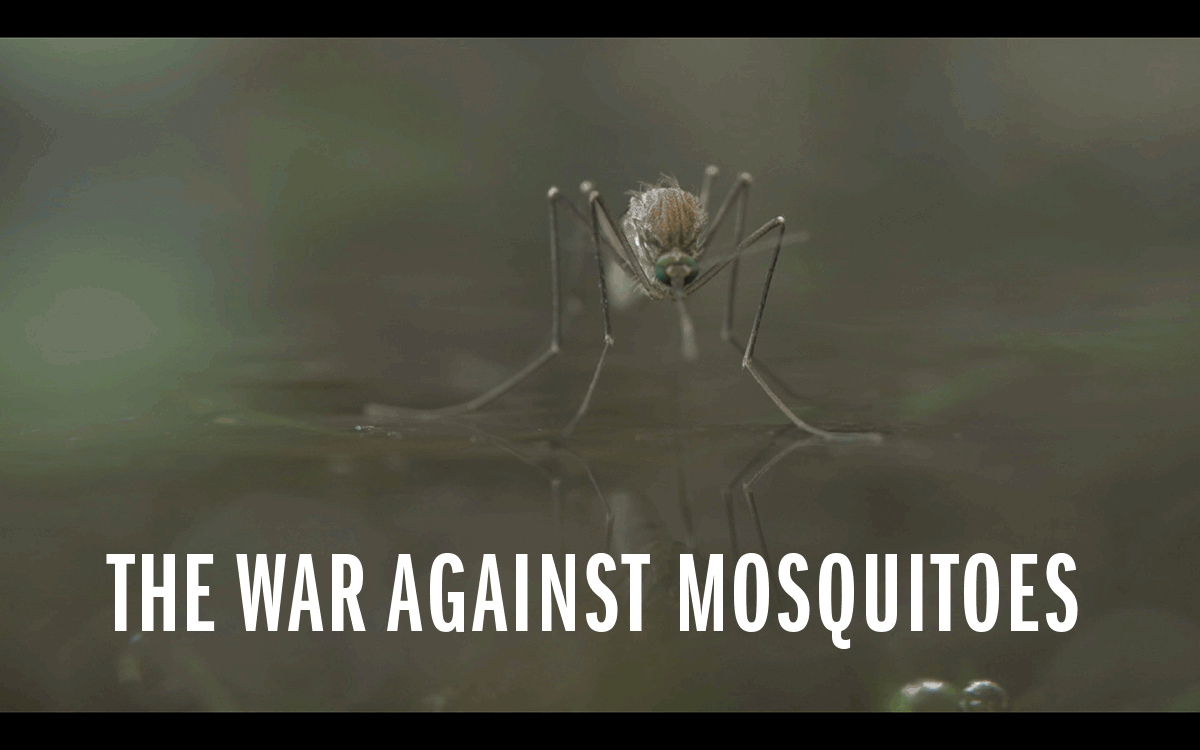A tale from the front lines
BY ALEXANDRA SIFFERLIN/piracicaba, brazil
If you’re waging a war, it helps to infiltrate the enemy.
At 7:00 a.m. on a February morning, a large gray van cruises through the streets of the Cecap and Eldorado neighborhoods in the east side of the southeastern Brazilian city of Piracicaba. It’s already 70 degrees and the air is already moist with the rain to come. After 150 meters of driving, an iPad alerts Cecilia Kosmann, an entomologist and production and field trial supervisor for the British biotech company Oxitec, to pull over. Kosmann grabs a plastic container, the kind you might normally fill with dinner leftovers, and rips off the lid. One thousand genetically modified (GM) male Aedes aegypti mosquitoes fall into a tubular bladeless fan that shoots the mosquitoes out the window and into the neighborhood to mate with wild females. If all goes right, those GM mosquitoes act as a biological Trojan Horse, eradicating the mosquito population from the inside, and stopping the spread of mosquito-borne diseases like chikungunya, dengue—and most pressingly, Zika.
Like most Brazilian cities, Piracicaba has been fighting the aegypti for years. Thanks to rapid urbanization—and the gradual resistance mosquitoes have built to once-effective insecticides like DDT—aegypti’s prevalence in the region has grown, and with it, the diseases the insect carries. In 2015, Brazil experienced over 1.5 million cases of dengue, up significantly from around 72,000 cases 12 years ago, and the city of Piracicaba alone tallied 3,718 cases.
Even more worrying is the explosive Zika outbreak, which has infected up to an estimated 1.5 million in Brazil and which has been linked to a spike in cases of the birth defect microcephaly. On Feb. 16, Piracicaba reported its second confirmed case of Zika, and the city says it expects more as the virus spreads. “We are really losing this war,” says Karla Tepedino, a production and field supervisor for Oxitec. “We need every kind of help we can have.”
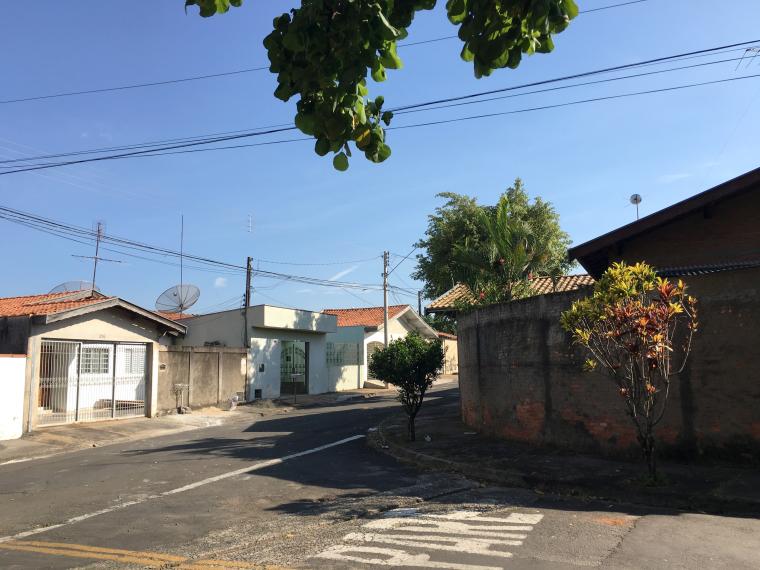
That’s why the city went on the offensive against aegypti in April 2015, when Oxitec began releasing genetically-modified mosquitoes in an short-term project. Oxitec promises a method of mosquito control that is cleaner than using pesticides and more effective than laboriously clearing out the aegypti habitat found everywhere in a tropical city like Piracicaba. “We believe it will be an alternative to the methods we’ve used to fight the mosquito for years without many results,” says the city’s mayor, Gabriel Ferrato.
It’s also controversial—some experts worry that tinkering with a species, no matter how pesky, could have unintended consequences familiar to anyone who has read Frankenstein. “When an ecological vacuum is created, another alternative species can trickle in,” says Phil Lounibos, an entomologist at the University of Florida. “They claim they are ready for that, but this has actually never been tested.” But with fears rising over the Zika outbreak—and other mosquito-borne viruses spreading to new territory—the time to test is here.
In a production facility about an hour away from Piracicaba on a campus called Techno Park, Oxitec is in full-blown mosquito manufacturing mode. The lab is a balmy 77 degrees and smells like fish food, which the scientists use to feed their mosquito larvae. One room is full of cages of mating mosquitoes, each one with 12,000 females for 4,000 males. After a couple of rather busy days for those mosquitoes, the scientists gather the newly laid eggs from the cages and let them dry, then put them into a vacuum chamber that spurs synchronized hatching. Once hatched into larvae, they are divided into trays with water, where they are grown for eight days.
On day eight, when the larvae have grown into pupae, the scientists sort the males from the females using a sieve-like tool, since the males are smaller. The male pupae are then put into plastic containers to grow into adults and be released into the wild, while the females are killed. Some males and females are reared to adulthood and put back into the mating cages to continue Oxitec’s lab-created circle of life.
Oxitec was founded in 2002 as a spin-off from a lab at Oxford University. The company’s mosquito was created by the researcher Luke Alphey, a geneticist who is now at the The Pirbright Institute in the United Kingdom. Oxitec’s focus is on developing and then bringing to market methods of using genetic engineering to control insects that spread disease or hurt crops. The company, which was small and privately owned, was bought in 2015 by the American biotech giant Intrexon Corporation for $160 million. The move increases the company’s competitiveness in a growing market that uses lab-tweaked species to reach health and production goals. Aside from Oxitec’s disease-fighting mosquitoes, it has also created modified versions of bugs that harm agriculture, including the diamondback moth, the pink bollworm, the medfly, the mexfly and the olivefly. Early field tests for those pests are in the works.
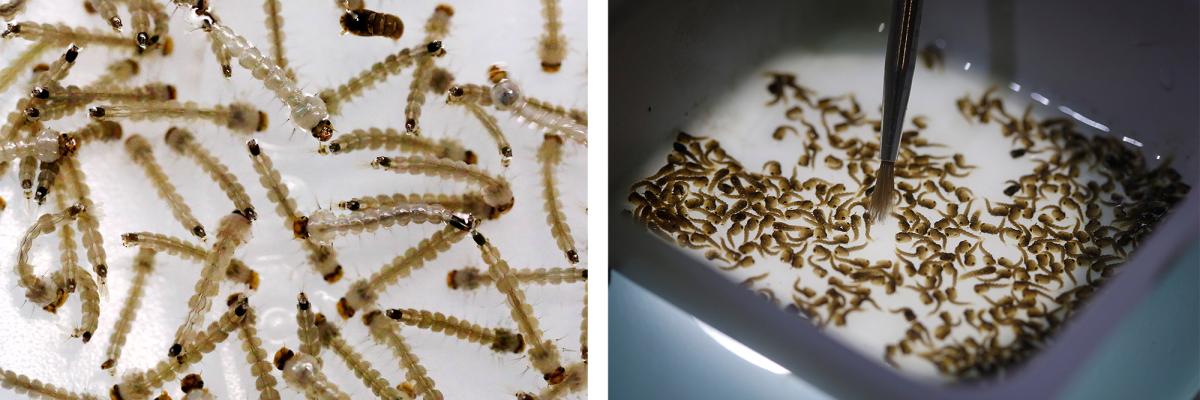
Each genetically modified mosquito is virtually identical to ordinary aegypyti mosquitoes with the exception of two unique genes. One gene causes the insects to overproduce a specific protein, rapidly killing them. The other gene turns the mosquitoes fluorescent under a microscope, so that the scientists can gather eggs in the field, hatch the larvae in the lab, and examine the larvae under a microscope for their glow, which helps them understand how widespread the GM infiltration has been. The modified male mosquitoes live long enough to mate with the wild females and pass on the two genes, killing the offspring before they reach adulthood, which causes the whole population of mosquitoes to dwindle.
Since female mosquitoes are the ones that bite and spread disease, Oxitec only releases modified males so that there is no risk that their lab-bred mosquitoes could spread infection. Even if a small percentage of the offspring of the modified mosquitoes don’t die before adulthood—usually around 5% or less, according to Oxitec—they’re generally too weak to hold up against the demands of nature and won’t survive long. “It is not like a crop where you are putting an advantage into the crop that spreads through generations,” says Oxitec CEO Hadyn Parry. “What [we] are actually doing is putting in a huge disadvantage. [We’re] stopping the reproduction.” And that’s why Oxitec’s method is potentially so revolutionary.
Since April 2015, Oxitec has released around 29.7 million male mosquitoes through the district where around 5,000 people reside—which gives you a sense of just how well-established the aegypti has become here. The numbers suggest the project is working: since trials began, the wild mosquito larvae population in the area has dropped 82% compared to a control area without Oxitec’s mosquitoes. In January, amid growing concern about the Zika virus—3 to 4 million additional infections are expected in the Americas over the next year—the company and Piracicaba announced the project will expand to a geographic area of up to 60,000 residents. “It is safe and it works. It’s environmentally friendly. The cost benefit will be extremely high,” says Glen Slade, director of Oxitec Brazil. “We’ve been working with this solution for over 13 years now. There will always be ways to optimize, but we are ready to deliver at scale. There’s nothing about the way we do [this] now that can’t be done 100 times larger.”
There are challenges along the way, including a straightforward one: how do you keep a species that is genetically modified to die off quick alive long enough to reproduce? The scientists house the mosquito larvae in a bath of water and tetracycline, a type of antibiotic that’s banned for use as an additive for animal growth or food preservation in Brazil, though it’s still used in other countries in humans and livestock. The antibiotic blocks the lethal protein replication that’s introduced by the engineering, keeping them alive in the lab long enough to be released into the wild, where they can wreck havoc on other mosquitoes.
But that raises another question: is possible for the GM mosquitoes or their offspring to come in contact with tetracycline in the wild, and then theoretically stay alive and continue mating? Oxitec’s Tepedino argues that even if the mosquitoes could survive, they would be too weak to pose a threat. “A small percentage could survive but they were reared in labs,” she says. “They are not very fit outside of here.” Oxitec says it has also tested whether environmental exposures to tetracycline could impact survival, and found levels are too low for any effect.
To skeptics, that’s exactly the problem. There’s no way to control with confidence the environment the GM mosquitoes will be released into—or how those insects will respond in the crucible of life. “People become experiments that they can’t opt out of,” says Dana Perls, a food and technology policy campaigner at the environmental group Friends of the Earth. “We don’t know how the GM mosquito would thrive in the wild. It could cause more problems.” The sentiment that modified mosquitoes add to the harm rather than curb it—whether accurate or not—isn’t uncommon. In a recent survey, when people were asked if they thought GM mosquitoes caused Zika or were being used to fight it, 30% said they thought those modified mosquitoes were the culprit.
Others are wary about the risk of relying solely on one form of mosquito control. “It’s important to have more than one tool,” says Anthony James, a professor at the University of California, Irvine who is working on a malaria-fighting mosquito. “We learned that with DDT. DDT shut down a lot of research because people thought, ‘oh, we have the magic bullet!’ It didn’t solve all the problems, [and] we are back at a situation where it’s worse now.”
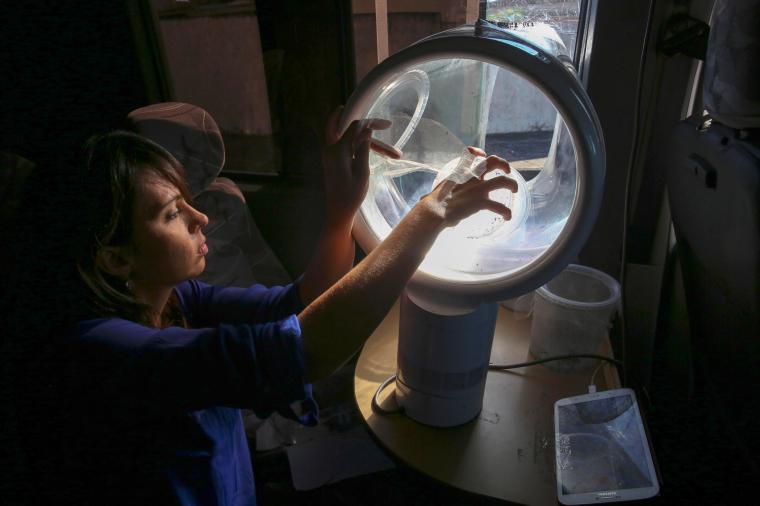
Even though some Piracicaba residents remain skeptical of GMOs, Oxitec claims it has a nearly 90% approval rating among the city residents. In addition to its field projects, the company has spent a lot of time educating the community about how the GM-mosquitoes work, and why they’re good for the city. But for many residents, the very real experience of dengue—and the fear of Zika—is a strong enough argument in favor of experimentation. From July 2014 to July 2015, there were slightly over 130 cases of dengue in the neighborhoods where Oxitec is currently working. So far, there has only been one case of dengue since July 2015.
Madlaine Teixeira, a healthcare worker for the city, went door-to-door answering residents’ questions about Oxitec before the initiative rolled out. She says she supports the method because she caught dengue last year and will never forget it. “My body was in a lot of pain, and I had a high fever. I laid down in bed and stayed there for 10 days,” she recalls. “I don’t want anybody to go through what I went through.”
While Oxitec has conducted field projects in countries like Panama and the Cayman Islands, the explosive Zika outbreak—and Brazil’s desperation to stop it—has put new light on the technology. The company has approval from Brazil’s National Biosafety Committee for mosquito release projects in Brazil, but it’s still waiting for commercial approval from health officials so it can market and sell its mosquitoes as a company would sell a drug of vaccine. Other research groups beyond Oxitec are also developing strategies that use the mosquito as a weapon against itself. In Rio de Janeiro, scientists are testing a method where they infect mosquitoes with bacteria called Wolbachia that limits their ability to transmit dengue on to humans. Their approach has had success in Australia, where an experiment in Townsville, a small city in Queensland is also ongoing.
But even with scientists working on novel if controversial weapons, the world is still losing the battle against the mosquito—largely because until recently, it had stopped fighting. By the late 1960s, mosquito-borne diseases were no longer considered a global threat outside of Africa due to large-scale control programs that utilized insecticides like DDT that are now considered toxic. But that success fueled a growing complacency, shrinking the pool for funding. Mosquito-borne diseases—which were once a major health problem in developed countries like the U.S. and Italy—seemed like something only the tropical poor needed to worry about. “When you have good public health, nothing is happening, so people are asking, why are you spending money on this?” says University of California, Irvine’s James. “What happens is funds are withdrawn, the insects come back, and in many cases the problem is much worse than if you had been able to maintain that all along.”
At the same time, skeptics wonder what could go wrong even if Oxitec’s technology goes right. Aegypti are not native to the Western Hemisphere, so there’s an argument that they can be removed like any other invasive species. But since they’ve settled into local ecosystems, their absence could have a cascade effect. “We don’t think wiping out the species is a realistic risk, but if you interfere with the numbers of species then you can have effects both directly on humans in terms of their immunity to disease but also on other species,” says Helen Wallace director of GeneWatch U.K. “Oxitec has been pushing to say that this technology is ready for prime time and that they can roll it out as a commercial application but we don’t think there’s been adequate safety testing of the genetic change itself.”
Researchers note that even if the aegytpi are eliminated, it’s possible another type of mosquito could step up and start spreading dengue or Zika. “It has been observed previously that if a vacant niche is created by suppressing or locally eradicating Aedes aegypti, an ecological homologue may move in, most likely the invasive Asian Tiger Mosquito, Aedes albopictus, which is just as good a vector of Zika, dengue, and chikungunya, as aegypti,” says the University of Florida’s Lounibos.
Oxitec’s struggles in the U.S. underscore just how controversial this weapon in the war against mosquitoes is. The company currently has a pending application with the U.S. Food and Drug Administration (FDA) for a release project in the Florida Keys, where the aegypti mosquito is present. Oxitec opened its application with the FDA in 2011, and while the stateside aegypti mosquitoes don’t currently transmit Zika, experts have suggested future transmission on a small scale could be possible if the aegypti come in contact with infected travelers who bring Zika back with them from hard-hit countries. While early surveys suggested that most Keys residents were in favor of the project—which was initially proposed as a way to fight dengue—a change.org petition filed by a local resident protesting the project has garnered well over 160,000 signatures. The application is still pending FDA determination, and people on both side of the debate are awaiting the decision.
“We are very concerned that we don’t really know about what will happen if you put a genetically modified mosquito into our local environment,” says Michael Welber, a Florida Keys resident and environmental activist. “As a country we have a tendency to overreact to these things and then do things that we later regret and wish we could take back.”
Beth Ranson, a representative for the Florida Keys Mosquito Control District, is less sanguine about the city’s ability to control the aegypti with its current complement of weapons. “We are a very aggressive mosquito control district—probably more than most you will find,” she says. “We 65 full time employees, we have people that go out every day in the field and to homes and to do inspections—they even climb under the houses. We do area larvicide treatments. We fly with helicopters we spray insecticide. But even with everything that we do, you need to have 2% or less of the homes in an area producing aegypti mosquitoes, whereas we have on average 10% of the houses producing. It is still too high.” The Florida Keys Mosquito Control District approached Oxitec about the project several years ago, but its board is waiting for an environmental assessment of the project from the FDA before making a final decision.
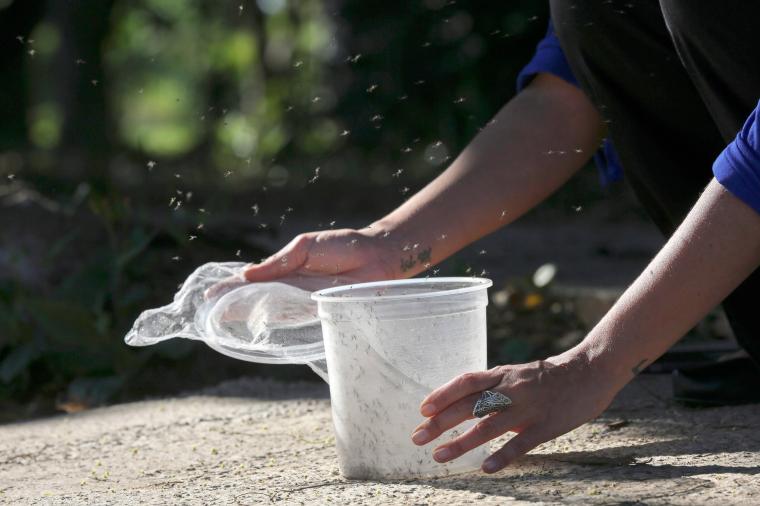
Still, it may be hard to convince Americans that releasing swarms of genetically modified mosquitoes is a good idea. “I don’t see it by any stretch as a panacea,” says Lounibos, though he adds that the method is unlikely to cause real harm. “Without dengue or another viral disease such as Zika, there really isn’t such a strong push or need for Oxitec’s high-tech methods because they’re pretty expensive. But you really have to stretch your imagination to see how this genetically modified aegypti is likely to have a serious consequence on human populations or on the ecosystem…In principal the GM gene does not last in nature.”
In Brazil, where the danger posed by mosquitoes is now very much real, the Piracicaba City Hall is investing roughly US $3,140 a month for the ongoing project. Still, it’s just one project within a large country entrenched in an evolving health problem. “We are very optimistic, but it’s not possible to apply that on a more representative part of the country,” says Dr. Cláudio Maierovitch, the director of the department of communicable disease surveillance at the Brazil Ministry of Health.
The mosquito is the deadliest creature in the world to human beings because it is so adept at carrying—and transmitting—dangerous viruses. But at the same time, genetically tweaking insects and releasing them into the wild is hardly without risk. Yet whether genetically modified mosquitoes—Oxitec’s version or others—will be used on a widespread scale may ultimately depend more on social acceptance than whether the science is ready to scale up. But taking the time to get it right remains critical, even amid desperate circumstances. “As scientists want to be very careful about this,” says UC Irvine’s James. “Because none of us want to be known for creating some kind of disaster.”
